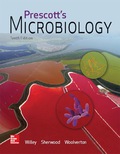
Concept explainers
Many classification schemes are used to identify bacteria. These start with
Virion refers to the complete virus particle and a simplest virion comprise only a nucleocapsid and capsid. Nucleocapsid possesses a nucleic acid (RNA or DNA), and a capsid refers to a protein coat. Enveloped virus refers to the viruses possessing an envelope, whereas naked or non-enveloped virus refers to those viruses lacking an envelope. Capsid symmetry is of three types, namely complex, icosahedral, and helical. Most of the viruses possess either helical or icosahedral capsids. Virus is a distinct group of infectious agent responsible for causing several diseases in human. They can exist both intracellularly and extracellularly. Viruses have the ability to infect all known cell types, including bacteria, archaea, fungi, protists, plants, and animals.
Explanation of Solution
Primarily, students should determine various characteristic features of viruses that are appropriately common to differentiate them into two to three major groups and then categorize them further.
The content of nucleic acid (DNA or RNA) of viruses should be determined first. Further, other characteristics such as capsid geometry (complex, icosahedral, and helical), host cell (bacteria, archaea, fungi, protists, plants, and animals), presence of envelope (non-enveloped or enveloped), and natural environment could also be considered. However, students could not propose any of the biochemical tests as viruses are known to be metabolically inactive. Also, viruses neither could be classified based on oxygen requirements (aerobic or anaerobic) nor motility.
Want to see more full solutions like this?
Chapter 6 Solutions
Prescott's Microbiology
- How would you categorize a virus? a. as prokaryotic b. As Eukaryotic c. As archaeon d. none of the abovearrow_forwardWhat are the characteristics of bacteria? What are the characteristics of viruses? Be specific in describing the size, structure, shape, and reproductive cycle of each.arrow_forwardWhat is meant by the term “staphylococcus”? Bacteria that are round and arranged in clusters Bacteria that are round and arranged in chains Special bacteria that are spiral-shaped Bacteria that are rod-shaped and found in groupsarrow_forward
- Which type of pathogen is the easiest to destroy? Gram-negative bacilli Naked viruses Prions Gram-positive cocci Endosporesarrow_forwardBascillus bacteria is of which shape? a- rod shape b- spring like c- circle shape d- oval shapearrow_forwardA microbiologist sets up a serial dilution to analyze bacteria in raw milk. Tube 1 – 0.1 mL milk diluted in 9.9 mL sterile water Tube 2 – 0.1 mL milk from Tube 1 diluted in 9.9 mL sterile water Tube 3 – 1.0 mL milk from Tube 2 diluted in 9.0 mL sterile water What is the dilution of raw milk in Tube 3?arrow_forward
- Fill in the data table attached below Microorganism: Influenza virusarrow_forwardList four diseases caused by spore-forming bacteria.arrow_forwardIf a person contracted MRSA and no antibiotics are working on them, how would you go about finding a way to treat their infection? Describe, in detail, how you would devise a plan to save their life utilizing your knowledge of bacteria and viruses.arrow_forward
- Give an example of each of the following types of viruses a. Double stranded DNA b. Single stranded DNA c. Positive sense RNA d. Negative sense RNA e. Retrovirusesarrow_forwardHow will the following factors contribute to the ability ofbacteria to invade the host?A. Antigenic variationB. Penetration into the Host cell cytoskeletonarrow_forward“Disease caused by Gram positive species is more significant than that caused by Gram negative species.” Do you agree with this statement? Explain your reasoning, giving named examples of eacharrow_forward
- Basic Clinical Lab Competencies for Respiratory C...NursingISBN:9781285244662Author:WhitePublisher:Cengage



